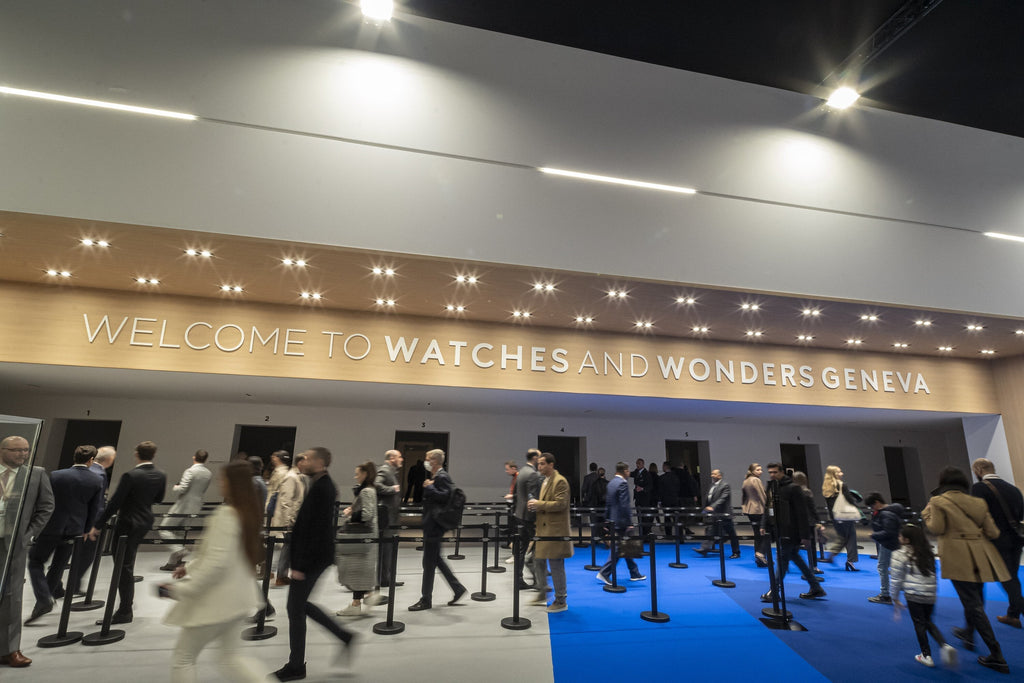Alpina
Alpina is a premium watchmaking company that has been operating out of Geneva, Switzerland for more than 135 years. Recognizable by its signature red triangle, Alpina watches are made in Switzerland.
Patents and innovative calibres are only two of the many firsts that Alpina, a true pioneer in the Swiss watchmaking industry, is responsible for. Alpina is a genuine trailblazer in the industry. Alpina is widely regarded as the company that first introduced the notion of a Swiss sports watch when it released its now-iconic Alpina 4 model in the year 1938.
1883
Gottlieb Hauser founds the "Alpina Union Horlogère S.A (UH) / Schweizerische Uhrmacher-Genossenschaft (SUG)" ("Corporation of Swiss Watchmakers"). His vision was the "Alpinist Principle": uniting Swiss watchmaking industry forces to accomplish the highest manufacturing quality and technological innovation under the most favourable conditions. The Union soon began manufacturing its own calibres.
1890
The Union relocates its headquarters to Biel/Bienne, where prominent member Jacob Straub operated his calibre factory (J. Straub & Co). At that time, the Geneva-based Alpina Ebauches factory, owned by Duret & Colonnaz, manufactured ébauches.
1900
The Alpina Union Horlogère takes part in the 1900 Universal Exposition in Paris and exhibits its calibres and creations to a distinguished and international audience.
1901
Jacob Straub registers the trademark "Alpina" to safeguard his previously unmarked 12- and 19-line calibres. As J. Straub & Co. is the Union's primary calibre supplier, virtually all high-end timepieces now bear the renowned "Alpina" insignia on their movements. As a result, Alpina was initially used as a protection and quality mark for exceptional movements.
1903
Gottlieb Hauser and his son undertake a perilous mission to Russia in order to establish a stronghold in the Tsarist empire. At the conclusion of their 50-day journey, their ledgers are filled with the names of a surprising number of new customers, some of whom are renowned. In 1955, Gottlieb Hauser Jr. penned "From Bienne to Astrakhan: The Adventures of a Swiss Watch Representative in Russia Fifty Years Ago" as an account of this journey.
1908
In celebration of its 25th anniversary, the Union registers the "Alpina" watch brand. For reasons of prestige, the Union members, the "Alpinists", agreed to use the brand "Alpina" only for watches that housed specified high-quality calibres, such as those with Breguet hairsprings and compensating balances. As was customary during this era, a potent name required a unique insignia; thus, the legendary Alpina red triangle emblem, the "Alpiner," was created.
1909
The Alpina Union Horlogère establishes the "Pracisions-Uhrenfabrik Alpina Glashütte i/S" in Glashütte, Germany, to manufacture watches. Geneva, Biel, Besançon (F), and Glashütte were now home to the Union's factories.
1910
The Alpina Union Horlogère produces a perpetual calendar complications for pocket watches. A significant technical obstacle for the time period.
1910
In its Glashütte facility, Alpina produces its first chronograph. In Switzerland, these timepieces were finely adjusted by W.A. Dubois, a renowned expert in his field. On their dials and mechanisms, these costly items bore the inscription "Pracisions-Uhrenfabrik Alpina Glashuütte iS." They were sold with a guarantee certificate and a lavish etui.
1913
Alpina Chronometers are acquired by the German navy (K.M. ). An Alpina 21-ligne Glashütte Chronometer, equipped with an Alpina chronometer ebauche with Glashütte escapement as opposed to the typical Swiss anchor escapement, was adopted by K.M. as standard equipment to fulfill its need for high precision time instruments.
1915
A gold medal is awarded to the Alpina Union Horlogère at the Swiss National Exhibition.
1915
Unprecedented prolongation of the success tale that began after the First World War. Alpina timepieces were distributed by approximately 2,000 retailers in Europe. Watches by Alpina were available in Lisbon, Amsterdam, Copenhagen, London, Stockholm, and even Santiago, Chile.
1921
Alpina becomes a prominent manufacturer and distributor of time instruments for military pilots.
1926
Alpina establishes a global quarantine for watches. In 1908, the guarantee was first implemented for Switzerland, and in 1926, it was extended to the rest of the globe. The first of its kind, Alpina's comprehensive international guarantee system confirmed the internationality and marketing acumen of the Brand, in addition to the high quality and dependability of Alpina timepieces.
1929
Alpina and the American company Gruen form a joint venture to gain access to their respective distribution networks and manufacturing facilities. The partnership produced the Alpina "Teno" watch, which houses the renowned 877 calibre. The "Tecno" advertising brochure stated, "The new "Tecno" chronometer wristwatch features an innovative movement and displays the exact time in seconds: for physicians, engineers, technicians, transit officials, merchants, and athletes."
1933
The "Block Uhr" is Alpina's inaugural sports timepiece. It featured an all-steel case and a newly patented crown design (Brevet 1464). The innovation comprised of a connection between the crown and the winding stem that was extremely snug to prevent particles from entering. In addition, the crown could not be removed or misplaced. This first sport watch evolved into the "Alpina 4" in 1938 due to accelerated technological advancement.
1938
The legendary "Alpina 4" is introduced by Alpina. The number "4" alluded to the four most important characteristics of a sports watch: The case is antimagnetic, water-resistant, shock-resistant, and made of stainless steel. The Alpina "4" philosophy revolutionized the sports watch, and the rugged-to-the-extreme "Alpina 4" became the watch of choice for sport and professional activities in unnatural and potentially hazardous environments for man, including the mountain, the air, and the sea. The hand-wound Alpina 592 calibre was one of the most robust watch "engines" of its era and was installed in the Alpina "4".
1945
Alpina produces its first automatic mechanism. The 1212-ligne, 5.5-mm-tall, self-winding calibre 582, also known as the "P82," featured a seconds sub-dial at 6 o'clock and a power reserve of 40 hours.
1948
The watchmaking school at the cantonal polytechnic in Biel selects the 12-ligne hand-wound Alpina calibre 592 as its didactic movement. This choice emphasizes that this movement was particularly precise, dependable, and robust.
1953
Alpina commemorates its seventieth anniversary by releasing the "Alpina 70" sport watch, which houses the 592 and 598 calibres. The "Alpina 70" was equipped with the four Alpina sport features (anti-shock, anti-magnetic, water-resistant, and stainless-steel case), and a gorgeous gilded "Alpiner" adorned its dial.
1957
The President of Alpina is revealed. The President is the company's first Sports Automatic, using the 584 "Hammerautomatik" calibre with 17 jewels and automatic winding.
1959
The "Alpina 4" Chronograph is presented by Alpina. The dial included a telemeter and a units-meter, making it suitable for use in sports and industrial settings.
1963
The Alpina calibre 362 (6½ lines) automatic movement for women is the tiniest and most robust of its kind. It utilized a rotor system that turned in both directions. In the same year, Alpina introduces the "Comtesse" line for women.
1968
Launch of the "Tropic-Proof" Alpina. This exquisite sport watch with a "Qualité Geneve" case featured the following four Alpina sport features: The case is anti-shock, anti-magnetic, water-resistant, and made of stainless steel. The "Tropic Proof" was advertised at the time as the "Grand Tourisme" of sport timepieces.
1969
Launch of the Alpina Diver "10 Seastrong". This professional diving watch was moved by a17 jewel Automatic self-winding caliber. The "10 Seastrong" featured 2 crowns, one of which was used to determine the decompression time through a 1-60 min. rotating bezel. The "Seastrong" was water resistant to 200m and anti-magnetic.
1970
Alpina introduces the "Dispomatic" Automatic Alarm encased in a modified Lemania 2980 calibre with 21600 A/h and 19 jewels. Despite the increasing demand for quartz watches during this time period, Alina continued to specialize in mechanical watches.
2002
Aletta and Peter Stas, the proprietors of Frédéric Constant, acquire Alpina. Identifying with the "Alpinist principle", they endeavoured to advance Gottlieb Hauser's vision for Swiss sport watch manufacturing.
2003
Alpina unveils its first sports collection under new ownership at the international BaselWorld watch exhibition.
2005
Alpina introduces the AL-650 hand-wound regulator movement, which is based on the famous Unitas Ebauche pocket watch calibre. Launch of the professional Alpina "Extreme Diver" watch, water-resistant to a depth of 1,000 meters (3,280 feet). The "Extreme Diver" features a helium escape valve and a sapphire crystal case back, which is uncommon for timepieces designed for these extreme depths.
2009
Alpina unveils its "Extreme Tourbillion" encasing the AL-980 Tourbillon manufacture calibre, the company's first Tourbillon movement in its century-long history. The AL-980 incorporates two significant new technologies: a Silicon escapement wheel and anchor provide the calibre with flawless accuracy, even in extreme conditions, because no lubrication is required to lubricate the escapement mechanism. The S.M.A.R.T. Weight Balancing System (patent pending) permits further precision enhancement of the movement. Alpina becomes the Official Timekeeper for Sebring, Florida's 12 Hours of Sebring endurance race.
2011
Alpina introduces its Extreme Sailing "Yacht Timer" with the new AL-880 movement. Alpina designed a specific mechanical module based on the SW500 chronograph to time the 5- and 10-minute countdown to the Regatta's departure line. In the event that the departure is interrupted, the AL-880 movement allows the countdown to be held and then released. The release of the AL-710 tiny date automatic manufacture calibre by Alpina. A refinement of Alpina's first Manufacture Calibre since its relaunch. The addition of a central second by the AL-710 to this automatic movement.
2012
Alpina presents the Startimer Pilot "Worldtimer Manufacture" featuring the AL-718 automatic World Time calibre, which was developed and manufactured in-house. The AL-718 is based on the AL-710 Manufacture Calibre and features a 24-hour time zone display, a night/day indicator, and a date window at 6 o'clock. It is extremely simple to operate: a single crown controls all of its functions.
2013
Alpina commemorates 130 years of manufacturing sports watches.





